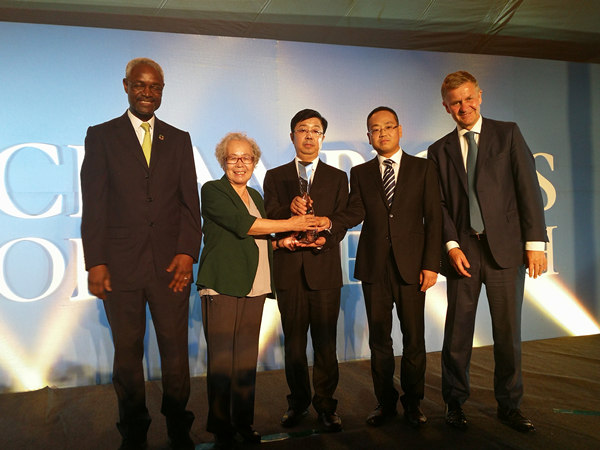

|
A bird's eye view of Novozymes' fermenting facilities for industrial enzymes at its Taicang facility. |
TAICANG, Jiangsu: Novozymes, the world leader in bio-innovation, is looking to take advantage of the biotech boom and expand its presence in China.
In its efforts to increase capabilities in the bio-ethanol industry, especially for the development and production of enzymes used for cellulosic ethanol (a biofuel produced from wood, grasses, or the non-edible parts of plants) Novozymes has begun the latest expansion of its Hongda manufacturing facility in Taicang, making it the largest enzyme fermentation plant in the world.
It is the fourth expansion for the Suzhou Hongda Enzymes Co, situated about 50km north of Shanghai, since the facility was put into use in 1995.
Peder Holk Nielsen, executive vice-president of Novozymes A/S, says the expanded capacity will primarily focus on products for the bio-ethanol industry and signals an investment in both bio-ethanol and the expanding Chinese market.
"Even though we don't know exactly how the enzymes that could help convert agricultural waste into fuels look like yet, we are absolutely sure we will produce them at this plant," he says.
"The Taicang facility is one of Novozymes' strategic manufacturing locations, and this new expansion will enable us to accomplish more," Nielsen says.
Qian Weidong, the plant's general manager, says that in the last several years the demand for enzymes for bio-ethanol production as well as other uses has increased rapidly around the world. Since 2005 Hongda has expanded through a series of expansion projects and has more than tripled its employee numbers to about 300.
The second generation (g2) enzyme, which helps convert agricultural waste into sugar and is fermented to produce ethanol as vehicle fuel, is one of the most promising businesses for the Danish company as bio-ethanol is currently one of few viable renewable alternatives to gasoline and is capable of replacing gasoline partially or even totally for automobiles.
The United States, Brazil, and China have targets and roadmaps for the development of the bio-ethanol industry. By 2010 China aims to more than double its bio-ethanol production to cover 5 percent of the total transport fuel used with a target of 3 million tons fuel ethanol.
The first generation enzymes developed by the firm to break down corn starch into sugar and then into ethanol are widely used in America. But they have been widely blamed for pushing up global food prices, and China has suspended the use of food crops including corn in the production of bio-fuel.
The criticism doesn't apply to the g2 enzymes though, and Nielsen says that by 2030 bio-fuels can supply up to 23 percent in the global energy structure.
"We are very excited about enzymes for bio-fuels at Novozymes. It's the fuel made of natural resources. It reduces the environmental impact in transportation sector and creates economic growth in rural areas in countries that invest in bio-fuels," he says.
Presently the firm has about 100 researchers working on developing the enzymes - the largest research program at the company - and it is expected to deliver commercially feasible enzymes for cellulosic ethanol production in 2010.
"The trick is to find the right enzymes, like searching for a needle in a haystack," Nielsen says, and the company faces competition from other industrial giants.
"It's more difficult to break down bio-mass than starch," he says. He expects that by around 2015 the g2 enzymes will cost 30 cents per gallon, much above the 4-6 cents for g1 enzymes to generate the same amount of fuel.
"But for g2, raw materials are very cheap and easily accessible," Nielsen says. China, which already becomes its second largest market outside the US, is also involved in the research of the new generation enzymes.
Novozymes uses its Beijing R&D center for testing the g2 enzymes while half of the research, focusing on the molecular work, is conducted in California, US.
Novozymes also works with State-owned food and agriculture giant China Oil and Food Corporation, more commonly known as COFCO, on a facility capable of producing bio-fuel from cassava - regarded as a "generation 1.5" bio-fuel technology.
It is also involved a pilot second-generation bio-fuel project of COFCO in Harbin in northeast China.
"We are very pleased with the strong commitment from Chinese government to develop bio-fuels from bio-mass," says Nielsen, who envisions a prosperous world because of improved bio-technology.
"That is what we call a bio-based society where farmlands not only produce food and textile fibers, but also materials today we produce through chemicals," he says.
(China Daily 12/22/2008 page5)













